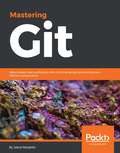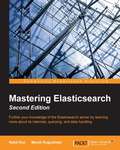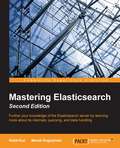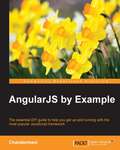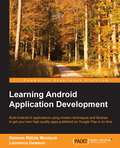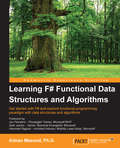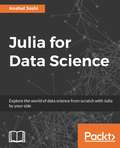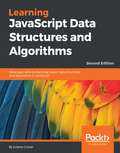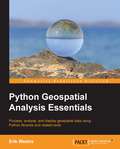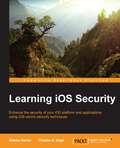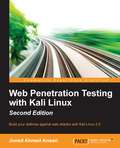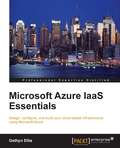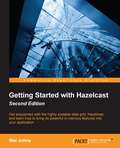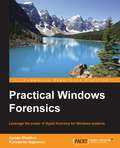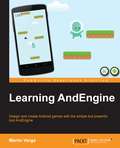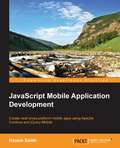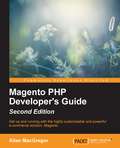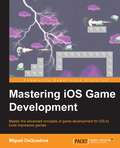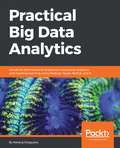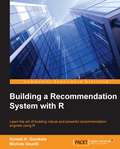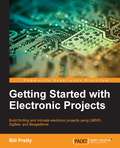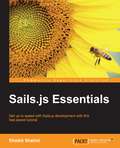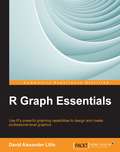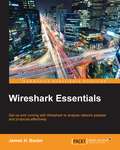- Table View
- List View
Mastering Git
by Jakub NarebskiAttain expert-level proficiency with Git for enhanced productivity and efficient collaboration by mastering advanced distributed version control features About This Book * Set up Git for solo and collaborative development * Harness the full power of Git version control system to customize Git behavior, manipulate history, integrate external tools and explore platform shortcuts * A detailed guide, which explains how to apply advanced Git techniques and workflows and ways to handle submodules Who This Book Is For If you are a Git user with reasonable knowledge of Git and familiarity with basic concepts such as branching, merging, staging, and workflows, this is the book for you. Basic knowledge of installing Git and software configuration management concepts is essential. What You Will Learn * Explore project history, find revisions using different criteria, and filter and format how history looks * Manage your working directory and staging area for commits and interactively create new revisions and amend them * Set up repositories and branches for collaboration * Submit your own contributions and integrate contributions from other developers via merging or rebasing * Customize Git behavior system-wide, on a per-user, per-repository, and per-file basis * Take up the administration and set up of Git repositories, configure access, find and recover from repository errors, and perform repository maintenance * Chose a workflow and configure and set up support for the chosen workflow In Detail Git is one of the most popular types of Source Code Management (SCM) and Distributed Version Control System (DVCS). Despite the powerful and versatile nature of the tool enveloping strong support for nonlinear development and the ability to handle large projects efficiently, it is a complex tool and often regarded as "user-unfriendly". Getting to know the ideas and concepts behind the architecture of Git will help you make full use of its power and understand its behavior. Learning the best practices and recommended workflows should help you to avoid problems and ensure trouble-free development. The book scope is meticulously designed to help you gain deeper insights into Git's architecture, its underlying concepts, behavior, and best practices. Mastering Git starts with a quick implementation example of using Git for a collaborative development of a sample project to establish the foundation knowledge of Git operational tasks and concepts. Furthermore, as you progress through the book, the tutorials provide detailed descriptions of various areas of usage: from archaeology, through managing your own work, to working with other developers. This book also helps augment your understanding to examine and explore project history, create and manage your contributions, set up repositories and branches for collaboration in centralized and distributed version control, integrate work from other developers, customize and extend Git, and recover from repository errors. By exploring advanced Git practices, you will attain a deeper understanding of Git's behavior, allowing you to customize and extend existing recipes and write your own. Style and approach Step-by-step instructions and useful information make this book the ultimate guide to understanding and mastering Git. This book will show road to mastery example by example, while explaining mental model of Git. The Introduction section covers the 'Essentials' just for refreshing the basics. The main highlight is that the concepts are based on HOW the technology/framework works and not just practical 'WHAT to do'.
Mastering Elasticsearch Second Edition
by Rafal Kuc Marek Rogozinski<P><P>Further your knowledge of the Elasticsearch server by learning more about its internals, querying, and data handling <P><P>About This Book <P><P>Understand Apache Lucene and Elasticsearch's design and architecture <P><P>Design your index, configure it, and distribute it, not only with assumptions, but with the underlying knowledge of how it works <P><P>Improve your user search experience with Elasticsearch functionality and learn how to develop your own Elasticsearch plugins <P><P>Who This Book Is For <P><P>This book is for Elasticsearch users who want to extend their knowledge and develop new skills. Prior knowledge of the Query DSL and data indexing is expected. <P><P>What You Will Learn <P><P>Understand Apache Lucene and Elasticsearch's design and architecture <P><P>Use and configure different scoring models to alter the default scoring mechanism <P><P>Choose the appropriate amount of shards and replicas for your deployment <P><P>Improve user search experience by utilizing Elasticsearch functionality <P><P>Control segment merging and learn why Elasticsearch uses merging <P><P>Develop custom Elasticsearch plugins and cover detailed examples of how to extend Elasticsearch by writing your own plugins <P><P>Apply your knowledge to create scalable, efficient, and fault tolerant clusters and monitor your cluster by using and understanding the Elasticsearch API <P><P>In Detail <P><P>Elasticsearch is a modern, fast, distributed, scalable, fault tolerant, and open source search and analytics engine. Elasticsearch leverages the capabilities of Apache Lucene, providing a new level of control over how you can index and search even huge sets of data. <P><P>This book covers intermediate and advanced functionalities of Elasticsearch and walks you through its internals including caches, the Apache Lucene library, and its monitoring capabilities. You'll learn about practical usage of Elasticsearch configuration parameters and how to use the monitoring API. <P><P>With this book, you'll delve into Elasticsearch's query rewrite, query template, bulk operation, document grouping, and function score queries. You will also learn how to improve user search experience, index distribution, segment statistics, and merging. By the end of the book, you will be able to enhance Elasticsearch's performance and create your own Elasticsearch plugins.
Mastering Elasticsearch - Second Edition
by Rafal Kuc Marek RogozinskiThis book is for Elasticsearch users who want to extend their knowledge and develop new skills. Prior knowledge of the Query DSL and data indexing is expected.
AngularJS by Example
by Chandermani<P><P>Learn AngularJS, and tackle the challenges of modern web development by creating your own applications with these practical examples you can use and adapt <P><P>About This Book <P><P>Learn the AngularJS development workflow and uncover a more effective way to build, deploy, and test applications <P><P>Explore the core components of AngularJS and find out how it makes JavaScript web development easier <P><P>Learn by example, as you create increasingly more complex real-world applications and dive deeper into AngularJS <P><P>Who This Book Is For <P><P>If you've always wanted to get started with AngularJS, this is an essential guide designed to help you do exactly that. Start building applications immediately with the featured examples, and uncover a simpler approach to JavaScript web development. You will need some prior experience with HTML, CSS, and JavaScript to get started. <P><P>What You Will Learn <P><P>Get to grips with Angulara ™s Model-View-Controller architecture Gain a understanding of single page applications from an AngularJS perspective <P><P>Manage code organization using modules and component dependencies with the Dependency Injection Framework <P><P>Find out how to use AngularJS directives to extend the behavior of HTML on your web page <P><P>Effectively use a range of JavaScript tools, from extending your app with jQuery plugins, to testing with Jasmine <P><P>Create forms for your single page applications and see how Angular helps you to bind, validate, and submit form data <P><P>In Detail <P><P>AngularJS makes web JavaScript web development less painful and more organized – it's unsurprising that today it's one of the most popular tools in web development. <P><P>AngularJS by Example helps you get started with this essential web development framework quickly and easily, guiding you through AngularJS by showing you how to create your own real-world applications. By adopting this approach, you can bridge the gap between learning and doing immediately, as you follow the examples to learn the impressive features of Angular and experience a radically simple–and powerful–approach to web development. <P><P>You'll begin by creating a simple Guess the Number game, which will help you get to grips with the core components of Angular, including its MVC architecture, and learn how each part interacts with one another. This will give you a solid foundation of knowledge from which you can begin to build more complex applications, such as a 7 minute workout app and an extended personal trainer app. By creating these applications yourself, you will find out how AngularJS manages client-server interactions and how to effectively utilize directives to develop applications further. You'll also find information on testing your app with tools such as Jasmine, as well as tips and tricks for some of the most common challenges of developing with AngularJS. <P><P>AngularJS by Example is a unique web development book that will help you get to grips with AngularJS and explore a powerful solution for developing single page applications.
AngularJS by Example
by ChandermaniIf you've always wanted to get started with AngularJS, this is an essential guide designed to help you do exactly that. Start building applications immediately with the featured examples, and uncover a simpler approach to JavaScript web development. You will need some prior experience with HTML, CSS, and JavaScript to get started.
Learning Android Application Development
by Laurence Dawson Raimon Rafols MontaneBuild Android N applications using modern techniques and libraries to get your own high-quality apps published on Google Play in no time About This Book * Get started with Android development, from the installation of required tools to publishing to the market * Make your applications Android N ready--Android has evolved quite a lot since the very beginning and so has their Software Development Kit--so get up to speed * Save time and improve the quality of your applications with widely used open source libraries and dependency management Who This Book Is For Want to get started with Android development? Start here. What You Will Learn * Get to know how to use popular open source libraries to reduce time to market and avoid re-inventing the wheel * Automate your application's testing phase to avoid last minute crashes * Use dependency management to properly keep dependencies and updates under control * Efficiently show huge amounts of items in a list * Forget about memory and speed concerns * Publish and monetize your Android applications on Google Play * Persist your application data so it can continue working in offline mode * Don't let the UX break because of network issues In Detail The mobile app market is huge. But where do you start? And how you can deliver something that takes Google Play by storm? This guide is the perfect route into Android app development - while it's easy for new apps to sink without a trace, we'll give you the best chance of success with practical and actionable guidance that will unlock your creativity and help you put the principles of Android development into practice. From the fundamentals and getting your project started to publishing your app to a huge market of potential customers, follow this guide to become a confident, creative and reliable mobile developer. Get to grips with new components in Android 7 such as RecyclerView, and find out how to take advantage of automated testing, and, of course, much, much more. What are you waiting for? There's never been a better time - or a better way - to get into Android app development. Style and approach More than just a manual, this is an accessible route into Android development. Packed with examples that demonstrate how to put key concepts and ideas into practice, this guide isn't just about learning, it's about immediate development.
Learning F# Functional Data Structures and Algorithms
by Adnan MasoodIf you have just started your adventure with F#, then this book will help you take the right steps to become a successful F# coder. An intermediate knowledge of imperative programming concepts, and a basic understanding of the algorithms and data structures in .NET environments using the C# language and BCL (Base Class Library), would be helpful.
Julia for Data Science
by Anshul JoshiExplore the world of data science from scratch with Julia by your side About This Book * An in-depth exploration of Julia's growing ecosystem of packages * Work with the most powerful open-source libraries for deep learning, data wrangling, and data visualization * Learn about deep learning using Mocha.jl and give speed and high performance to data analysis on large data sets Who This Book Is For This book is aimed at data analysts and aspiring data scientists who have a basic knowledge of Julia or are completely new to it. The book also appeals to those competent in R and Python and wish to adopt Julia to improve their skills set in Data Science. It would be beneficial if the readers have a good background in statistics and computational mathematics. What You Will Learn * Apply statistical models in Julia for data-driven decisions * Understanding the process of data munging and data preparation using Julia * Explore techniques to visualize data using Julia and D3 based packages * Using Julia to create self-learning systems using cutting edge machine learning algorithms * Create supervised and unsupervised machine learning systems using Julia. Also, explore ensemble models * Build a recommendation engine in Julia * Dive into Julia's deep learning framework and build a system using Mocha.jl In Detail Julia is a fast and high performing language that's perfectly suited to data science with a mature package ecosystem and is now feature complete. It is a good tool for a data science practitioner. There was a famous post at Harvard Business Review that Data Scientist is the sexiest job of the 21st century. (https://hbr.org/2012/10/data-scientist-the-sexiest-job-of-the-21st-century). This book will help you get familiarised with Julia's rich ecosystem, which is continuously evolving, allowing you to stay on top of your game. This book contains the essentials of data science and gives a high-level overview of advanced statistics and techniques. You will dive in and will work on generating insights by performing inferential statistics, and will reveal hidden patterns and trends using data mining. This has the practical coverage of statistics and machine learning. You will develop knowledge to build statistical models and machine learning systems in Julia with attractive visualizations. You will then delve into the world of Deep learning in Julia and will understand the framework, Mocha.jl with which you can create artificial neural networks and implement deep learning. This book addresses the challenges of real-world data science problems, including data cleaning, data preparation, inferential statistics, statistical modeling, building high-performance machine learning systems and creating effective visualizations using Julia. Style and approach This practical and easy-to-follow yet comprehensive guide will get you learning about Julia with respect to data science. Each topic is explained thoroughly and placed in context. For the more inquisitive, we dive deeper into the language and its use case. This is the one true guide to working with Julia in data science.
Learning JavaScript Data Structures and Algorithms - Second Edition
by Loiane GronerIf you are a student of Computer Science or are at the start of your technology career and want to explore JavaScript's optimum ability, this book is for you. You need a basic knowledge of JavaScript and programming logic to start having fun with algorithms.
Python Geospatial Analysis Essentials
by Erik WestraIf you are an experienced Python developer and wish to get up-to-speed with geospatial programming, then this book is for you. While familiarity with installing third-party Python libraries would be an advantage, no prior knowledge of geospatial programming is required.
Learning iOS Security
by Allister Banks Charles S. EdgeThis book is intended for mobile security professionals who want to learn how to secure iOS operating systems and its applications. Any knowledge of iOS architecture would be an added advantage.
Web Penetration Testing with Kali Linux - Second Edition
by Juned Ahmed AnsariBuild your defense against web attacks with Kali Linux 2.0 About This Book * Gain a deep understanding of the flaws in web applications and exploit them in a practical manner * Get hands-on web application hacking experience with a range of tools in Kali Linux 2.0 * Develop the practical skills required to master multiple tools in the Kali Linux 2.0 toolkit Who This Book Is For If you are already working as a network penetration tester and want to expand your knowledge of web application hacking, then this book tailored for you. Those who are interested in learning more about the Kali Sana tools that are used to test web applications will find this book a thoroughly useful and interesting guide. What You Will Learn * Set up your lab with Kali Linux 2.0 * Identify the difference between hacking a web application and network hacking * Understand the different techniques used to identify the flavor of web applications * Expose vulnerabilities present in web servers and their applications using server-side attacks * Use SQL and cross-site scripting (XSS) attacks * Check for XSS flaws using the burp suite proxy * Find out about the mitigation techniques used to negate the effects of the Injection and Blind SQL attacks In Detail Kali Linux 2.0 is the new generation of the industry-leading BackTrack Linux penetration testing and security auditing Linux distribution. It contains several hundred tools aimed at various information security tasks such as penetration testing, forensics, and reverse engineering. At the beginning of the book, you will be introduced to the concepts of hacking and penetration testing and will get to know about the tools used in Kali Linux 2.0 that relate to web application hacking. Then, you will gain a deep understanding of SQL and command injection flaws and ways to exploit the flaws. Moving on, you will get to know more about scripting and input validation flaws, AJAX, and the security issues related to AJAX. At the end of the book, you will use an automated technique called fuzzing to be able to identify flaws in a web application. Finally, you will understand the web application vulnerabilities and the ways in which they can be exploited using the tools in Kali Linux 2.0. Style and approach This step-by-step guide covers each topic with detailed practical examples. Every concept is explained with the help of illustrations using the tools available in Kali Linux 2.0.
Microsoft Azure IaaS Essentials
by Gethyn EllisThis book is intended for system administrators and other IT professionals who need to both design and implement an Azure-based cloud solution. With the help of this book, you will soon master the basic tasks needed to build a cloud-based solution.
Getting Started with Hazelcast - Second Edition
by Mat JohnsThis book is a great introduction for Java developers, software architects, or DevOps looking to enable scalable and agile data within their applications. <P><P>Providing in-memory object storage, cluster-wide state and messaging, or even scalable task execution, Hazelcast helps solve a number of issues that have troubled technologists for years.
Practical Windows Forensics
by Ayman Shaaban Konstantin SapronovLeverage the power of digital forensics for Windows systems About This Book * Build your own lab environment to analyze forensic data and practice techniques. * This book offers meticulous coverage with an example-driven approach and helps you build the key skills of performing forensics on Windows-based systems using digital artifacts. * It uses specific open source and Linux-based tools so you can become proficient at analyzing forensic data and upgrade your existing knowledge. Who This Book Is For This book targets forensic analysts and professionals who would like to develop skills in digital forensic analysis for the Windows platform. You will acquire proficiency, knowledge, and core skills to undertake forensic analysis of digital data. Prior experience of information security and forensic analysis would be helpful. You will gain knowledge and an understanding of performing forensic analysis with tools especially built for the Windows platform. What You Will Learn * Perform live analysis on victim or suspect Windows systems locally or remotely * Understand the different natures and acquisition techniques of volatile and non-volatile data. * Create a timeline of all the system actions to restore the history of an incident. * Recover and analyze data from FAT and NTFS file systems. * Make use of various tools to perform registry analysis. * Track a system user's browser and e-mail activities to prove or refute some hypotheses. * Get to know how to dump and analyze computer memory. In Detail Over the last few years, the wave of the cybercrime has risen rapidly. We have witnessed many major attacks on the governmental, military, financial, and media sectors. Tracking all these attacks and crimes requires a deep understanding of operating system operations, how to extract evident data from digital evidence, and the best usage of the digital forensic tools and techniques. Regardless of your level of experience in the field of information security in general, this book will fully introduce you to digital forensics. It will provide you with the knowledge needed to assemble different types of evidence effectively, and walk you through the various stages of the analysis process. We start by discussing the principles of the digital forensics process and move on to show you the approaches that are used to conduct analysis. We will then study various tools to perform live analysis, and go through different techniques to analyze volatile and non-volatile data. Style and approach This is a step-by-step guide that delivers knowledge about different Windows artifacts. Each topic is explained sequentially, including artifact analysis using different tools and techniques. These techniques make use of the evidence extracted from infected machines, and are accompanied by real-life examples.
Learning AndEngine
by Martin VargaIf you are a beginner to AndEngine, or mobile game development in general, and you are looking for a simple way to start making games for Android, this book is for you. You should already know the basics of Java programming, but no previous game development experience is required.
JavaScript Mobile Application Development
by Hazem SalehIf you are a native mobile developer, with some familiarity with the common web technologies of JavaScript, CSS, and HTML, or if you are a web developer, then this learning guide will add great value and impact to your work. Learning how to develop mobile applications using Apache Cordova is of particular importance if you are looking to develop applications on a variety of different platforms efficiently.
Magento PHP Developer's Guide - Second Edition
by Allan MacgregorThis book is written for PHP developers who are familiar with frameworks such as Zend or CakePHP and want to start developing and working with Magento. No prior knowledge of Magento is required.
Mastering iOS Game Development
by Miguel DequadrosMaster the advanced concepts of game development for iOS to build impressive games About This Book * Create a complete game with advanced techniques through the course of the book using in-depth, hands-on instructions * Learn how to multi-task and improve performance optimization in your game playing experience * The author, Miguel, has 11 years of iOS game development using xcode and has released over 10 games to the Apple AppStoreMaster player movement using touch controls as well as discuss motion controls Who This Book Is For This book is for those who have created an iOS game already and want to hone their skills. A reasonable level of knowledge and an understanding of the core elements and applications would be helpful. What You Will Learn * Blast off and start developing fun games * Optimize the assets for the best performance in the game app * Master player movement using touch controls as well as discuss motion controls * Perform bug Squashing by testing and debugging * Design interesting various characters and enemies for your game * Test your game on both, the simulator on the computer and on real devices * Tweak and fine tune the code and graphics before the release of your app * Uncover some awesome new gameplay by adding in multiplayer elements, to get more people playing together In Detail iOS is an operating system for Apple manufactured phones and tablets. Mobile gaming is one of the fastest-growing industries, and compatibility with iOS is now becoming the norm for game developers. SpriteKit is part of the native SDK from Apple, and enables developers to make simple entry into game development without unnecessary overhead and a long learning process. SpriteKit also provides other functionality that is useful for games, including basic sound playback support and physics simulation. In addition, Xcode provides built-in support for SpriteKit so that you can create complex special effects and texture atlases directly in Xcode. This combination of framework and tools makes SpriteKit a good choice for games and other apps that require similar kinds of animation. Become a master in iOS game development through this fast and fun guide! In the beginning, we'll tell you everything you need to plan and design your game. You'll then start developing your game through step-by-step instructions using the various built-in technologies of Xcode. From there on, we discuss how to deploy your game to the iOS App Store, as well as monetizing it to make more revenue. You will also learn advanced techniques to improve your game playing experience, including better multi-tasking, improved performance optimization, battery management, and more. To end the book off, we'll show you how to update your game with different features, then port the update to the App Store. Style and approach This book provides an easy-to-understand and fun approach to game development, with step-by-step instructions and detailed explanation of each block of code. The topics covered range from easy to advanced, so buckle up for a fast-paced ride!
Practical Big Data Analytics: Hands-on techniques to implement enterprise analytics and machine learning using Hadoop, Spark, NoSQL and R
by Giancarlo Zaccone Serguei Boldyrev Nataraj Dasgupta Patrick HannahGet command of your organizational Big Data using the power of data science and analytics Key Features A perfect companion to boost your Big Data storing, processing, analyzing skills to help you take informed business decisions Work with the best tools such as Apache Hadoop, R, Python, and Spark for NoSQL platforms to perform massive online analyses Get expert tips on statistical inference, machine learning, mathematical modeling, and data visualization for Big Data Book Description Big Data analytics relates to the strategies used by organizations to collect, organize and analyze large amounts of data to uncover valuable business insights that otherwise cannot be analyzed through traditional systems. Crafting an enterprise-scale cost-efficient Big Data and machine learning solution to uncover insights and value from your organization's data is a challenge. Today, with hundreds of new Big Data systems, machine learning packages and BI Tools, selecting the right combination of technologies is an even greater challenge. This book will help you do that. With the help of this guide, you will be able to bridge the gap between the theoretical world of technology with the practical ground reality of building corporate Big Data and data science platforms. You will get hands-on exposure to Hadoop and Spark, build machine learning dashboards using R and R Shiny, create web-based apps using NoSQL databases such as MongoDB and even learn how to write R code for neural networks. By the end of the book, you will have a very clear and concrete understanding of what Big Data analytics means, how it drives revenues for organizations, and how you can develop your own Big Data analytics solution using different tools and methods articulated in this book. What you will learn - Get a 360-degree view into the world of Big Data, data science and machine learning - Broad range of technical and business Big Data analytics topics that caters to the interests of the technical experts as well as corporate IT executives - Get hands-on experience with industry-standard Big Data and machine learning tools such as Hadoop, Spark, MongoDB, KDB+ and R - Create production-grade machine learning BI Dashboards using R and R Shiny with step-by-step instructions - Learn how to combine open-source Big Data, machine learning and BI Tools to create low-cost business analytics applications - Understand corporate strategies for successful Big Data and data science projects - Go beyond general-purpose analytics to develop cutting-edge Big Data applications using emerging technologies Who this book is for The book is intended for existing and aspiring Big Data professionals who wish to become the go-to person in their organization when it comes to Big Data architecture, analytics, and governance. While no prior knowledge of Big Data or related technologies is assumed, it will be helpful to have some programming experience.
Building a Recommendation System with R
by Michele Usuelli Suresh K. GorakalaLearn the art of building robust and powerful recommendation engines using R About This Book * Learn to exploit various data mining techniques * Understand some of the most popular recommendation techniques * This is a step-by-step guide full of real-world examples to help you build and optimize recommendation engines Who This Book Is For If you are a competent developer with some knowledge of machine learning and R, and want to further enhance your skills to build recommendation systems, then this book is for you. What You Will Learn * Get to grips with the most important branches of recommendation * Understand various data processing and data mining techniques * Evaluate and optimize the recommendation algorithms * Prepare and structure the data before building models * Discover different recommender systems along with their implementation in R * Explore various evaluation techniques used in recommender systems * Get to know about recommenderlab, an R package, and understand how to optimize it to build efficient recommendation systems In Detail A recommendation system performs extensive data analysis in order to generate suggestions to its users about what might interest them. R has recently become one of the most popular programming languages for the data analysis. Its structure allows you to interactively explore the data and its modules contain the most cutting-edge techniques thanks to its wide international community. This distinctive feature of the R language makes it a preferred choice for developers who are looking to build recommendation systems. The book will help you understand how to build recommender systems using R. It starts off by explaining the basics of data mining and machine learning. Next, you will be familiarized with how to build and optimize recommender models using R. Following that, you will be given an overview of the most popular recommendation techniques. Finally, you will learn to implement all the concepts you have learned throughout the book to build a recommender system. Style and approach This is a step-by-step guide that will take you through a series of core tasks. Every task is explained in detail with the help of practical examples.
Getting Started with Electronic Projects
by Bill PrettyThis book is aimed at hobbyists with basic knowledge of electronics circuits. Whether you are a novice electronics project builder, a ham radio enthusiast, or a BeagleBone tinkerer, you will love this book.
Sails.js Essentials
by Shaikh ShahidGet up to speed with Sails.js development with this fast-paced tutorial About This Book * Gain expertise in building web apps with Sails.js * Develop apps such as real-time chat app and more in no time * Helps you understand how MVC framework works in Node.js and how to make it work for you Who This Book Is For This book is for web developers who want to build web apps with Sails.js. Proficiency with JavaScript and Node.js is assumed, as well as familiarity with web development concepts. Familiarity with the MEAN (Mongo, Express, Angular, and Node) stack would be an added advantage. What You Will Learn * Find out to quick-start Sails.js and develop production-ready apps * Understand how to apply the MVC model of software development in Node.js using Sails.js * Discover how to write quality code using Sails.js * Integrate third-party APIs and databases such Mongo and MySQL in Sails.js * Get to know the advantages and importance of the MVC framework in software development In Detail Sails.js makes it easy to build custom, enterprise-grade Node.js apps. It is designed to emulate the familiar MVC pattern of frameworks, but with support for the requirements of modern apps: data-driven APIs with a scalable, service-oriented architecture. This book will provide practical examples to get you started with Sails.js and get you develop production-ready apps in no time. We will take you from a Node.js web server and single threading system to a general MVC architecture. You will then learn to develop applications that you might be already familiar with using Sails.js. Finally, we will show you how to create a chat app and a to-do application, and improve code quality using JSHINT and JSCS. Style and approach This practical and easy-to-follow yet comprehensive guide will help you get to grips with the Sails.js framework. Each topic is explained and placed in context, and for the more inquisitive, there are more details of the concepts used.
R Graph Essentials
by David Alexander LillisThis book is targeted at R programmers who want to learn the graphing capabilities of R. This book will presume that you have working knowledge of R.
Wireshark Essentials
by James H. BaxterThis book is aimed at IT professionals who want to develop or enhance their packet analysis skills. Basic familiarity with common network and application services terms and technologies is assumed; however, expertise in advanced networking topics or protocols is not required. Readers in any IT field can develop the analysis skills specifically needed to complement and support their respective areas of responsibility and interest.
